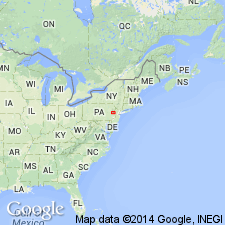
- Usage in publication:
-
- Clove Brook Member*
- Modifications:
-
- Named
- Dominant lithology:
-
- Limestone
- AAPG geologic province:
-
- Piedmont-Blue Ridge province
Summary:
Pg. 2 (fig. 1), 9-10, 48-51, pl. 1. Herein proposed that (1) name Decker Formation (=Decker Ferry Formation of Weller, 1900, New Jersey Geol. Survey Ann. Rpt. State Geol. 1899, p. 7; [also Weller, 1903, New Jersey Geol. Survey Rpt. on Paleo., v. 3]) be applied to strata lying between Bossardville Limestone and Rondout Formation in northeastern Pennsylvania and New Jersey, (2) the calcareous facies northeast of Hainesville area, New Jersey, be designated Clove Brook Member, and (3) the arenaceous facies southwest of Hainesville area be designated Wallpack Center Member. The Clove Brook is predominantly medium-gray to medium-dark-gray, medium- to coarse-grained, flaggy to massive, even-bedded, fossiliferous (generally crinoidal) limestone. Light-olive-gray silty shale partings occur near top. Silt content increases upward. Megafossils generally more abundant in coarser grained limestone beds. A massive bed of moderate-reddish-brown to dark-reddish-brown coarse-grained iron-rich fossiliferous limestone forms excellent marker bed within the member. Thickness 50.2 feet at type section. Becomes more arenaceous southwest of type locality and near Hainesville, New Jersey, is almost entirely replaced by Wallpack Center Member. Underlies Duttonville Member (new) of Rondout. Age is Late Silurian. Report includes measured sections. (Clove Brook Member of Decker Formation adopted by the USGS.)
Type section: in the abandoned William Nearpass quarry, 1.8 mi southwest of Duttonville, in northwest quarter of Port Jervis South 7.5-min quadrangle. Section is on the southeast slope of Wallpack Ridge. [Approx. Lat. 41 deg. 20.1 min. N., Long. 74 deg. 42.3 min. W., Sussex Co., NJ (A.G. Harris, written commun., ca. 1995)]. Named from Clove Brook, 0.5 mi northeast of the quarry, in Sussex Co., NJ.
Source: Publication; US geologic names lexicon (USGS Bull. 1350, p. 161); GNU records (USGS DDS-6; Reston GNULEX); Changes in stratigraphic nomenclature, 1967 (USGS Bull. 1274-A, p. A5).
For more information, please contact Nancy Stamm, Geologic Names Committee Secretary.
Asterisk (*) indicates published by U.S. Geological Survey authors.
"No current usage" (†) implies that a name has been abandoned or has fallen into disuse. Former usage and, if known, replacement name given in parentheses ( ).
Slash (/) indicates name conflicts with nomenclatural guidelines (CSN, 1933; ACSN, 1961, 1970; NACSN, 1983, 2005, 2021). May be explained within brackets ([ ]).

